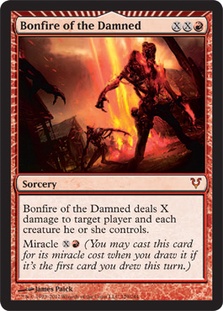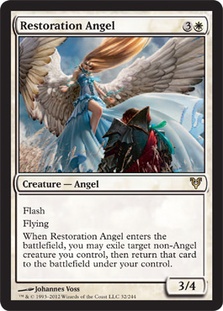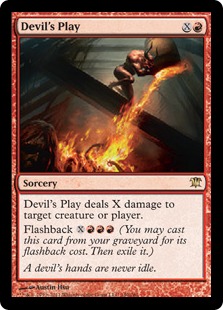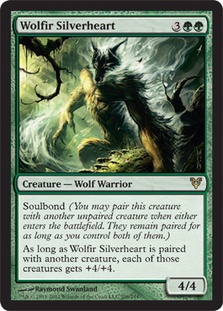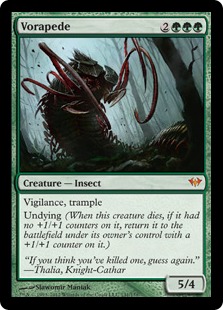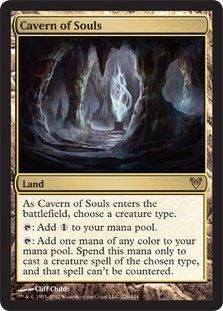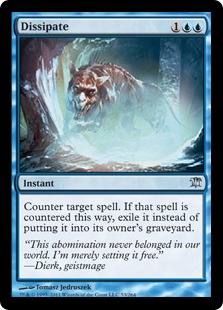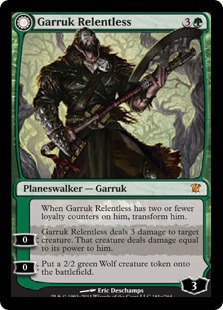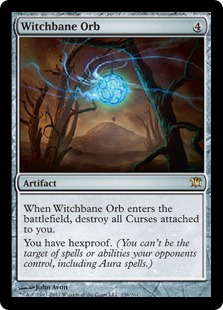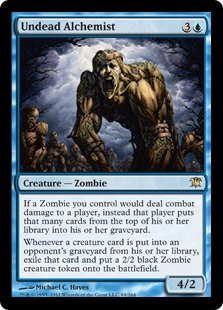Before Avacyn Restored was fully spoiled, Team SCG Black had a forum set up to discuss decks. When it became apparent that we wouldn’t have many dual lands to work with, Kai Budde posted a mono-white and mono-red aggro deck, because it didn’t seem to him like the mana would really work for two-color aggressive decks. These were posted well before I began testing, and I didn’t pay much attention to them until much later in the testing process.
My plan was to begin testing Constructed in New York City with Gaudenis Vidugiris, Patrick Chapin, Jon Finkel, Reid Duke, Alex West, Andrew Cuneo, and a little help from Zvi Mowshowitz before leaving for Barcelona a week before the Pro Tour. I started by working on various green based Huntmaster of the Fells decks. Patrick was working on U/W/R (or other color) control decks, which he ended up playing; Andrew was working on U/G/R Self-Mill, which he ended up playing; Jon was working on U/R Delver with Runechanter’s Pike; Reid had G/W Humans and some other decks; and Alex had built a very aggressive Boros deck with Stromkirk Noble and Champion of the Parish, similar to what Paul Rietzl played.
Later, Alex put together some lists from Magic-League that played baffling numbers of five-drops, like ten of them. Playing with those decks felt horrible, and I quickly dismissed them. I started to imagine how they could have come about. Midrange beat the R/W decks, and then people just kept going bigger until they found themselves there. They went too far though; there has to be a better solution. The Magic-League metagame had become inbred through lack of creativity.
Early on, I loved Huntmaster of the Fells, Bonfire of the Damned, and Restoration Angel. I experimented with a lot of cards and colors and mostly learned how build a consistent mana base in green (Abundant Growth).
After trying a slow four-color deck with a lot of removal and Griselbrand and a RUG build with Tamiyo, which really underperformed for me, I eventually came to the conclusion that I just wanted to kill my opponent. I cut Garruk and other planeswalkers and built the deck with the goal of getting my opponent into range of Devil’s Play. Zealous Conscripts was my five-mana spell. We’d played some with Wolfir Silverheart, but I still wasn’t willing to play very many fives and I just wanted to get immediate damage.
The deck was a step in the right direction but wasn’t quite there. I had too many mana guys and not enough good attackers. I later realized this was largely because of Huntmaster of the Fells, who I was beginning to figure out just wasn’t a good card in the format outside of very specific places.
The problem with Huntmaster is that it didn’t really kill anything that mattered. In Standard it has Delvers to hunt, but in Block it mostly just killed other Huntmasters. If I just didn’t have them, I could ignore my opponent’s.
Late into our testing in Barcelona, Alex West built a mono-green deck that just played all the mana creatures (Avacyn’s Pilgrim, Scorned Villager, and Dawntreader Elk) and a ton of monsters (four Wolfir Silverheart and four Vorapede). It splashed four Kessig Wolf Runs. Vorapede was very impressive. When it paired with Silverheart it attacked over everything and dominated the ground, and red had horrible answers to it. I was surprised more people didn’t play it at the PT. My least favorite thing about this deck was that it had to play Garruk as removal.
I tried building the deck with a white splash for Restoration Angel, but the consensus was that it wasn’t worth the pressure on the mana. The day before the tournament started, several of us were planning to play this deck, and we were just trying to decide if we wanted to splash a color for sideboard cards. Black was the leading contender for Sever the Bloodline against opposing monsters and Human Frailty against Boros. I didn’t like Human Frailty because so many of our black sources were Dawntreader Elk—it felt too slow for what we were trying to do.
I woke up early in the morning Thursday, the day we had to leave the apartment we’d been testing in, wanting to try blue in the green deck. If everyone was playing Wolfir Silverheart, as we were beginning to think they might, I felt like Silent Departure, Peel from Reality, or Into the Void could easily be game winning. I left my room to find only Alex awake on our patio. I asked what he thought of blue, and he said he didn’t really think games were about tempo. That seemed odd to me, but I shelved the idea and went to take a shower.
When I’d finished my shower and packing, others were awake, and Alex told me the consensus was that blue wouldn’t be very good, so I left it alone. We went to the player hotel and the site, and I talked to people outside of our team about the format.
I didn’t love our decks and had no idea what to play. I found Gerry Thompson and asked him if he wanted to get together and break it again. He graciously gave me the list of the mono-black deck he was working on. I took it back to Finkel’s room, where most of Team SCG Black was gathered, and asked everyone what they thought of it. Lack of sweepers meant you could fall behind too easily and lack of life gain meant you could get burned out. It seemed like a dead end.
At dinner, Tom Martell asked about U/G, and I said that’s what I’d wanted to do earlier but I thought people weren’t into it. I said I already basically knew what I wanted to do with it and that I’d come up with a sketch back at Jon’s room.
When we got to his room, I took out the boxes of cards I’d brought and started laying a deck out on the bed.
Creatures (24)
- 4 Invisible Stalker
- 4 Avacyn's Pilgrim
- 3 Geist of Saint Traft
- 4 Strangleroot Geist
- 3 Dungeon Geists
- 4 Wolfir Silverheart
- 2 Wolfir Avenger
Lands (23)
Spells (13)

Kai came into the room just as I was finishing, and I asked what he thought. He kind of shrugged and said he thought it might work—it was at least worth trying. Note that was late in the evening the night before the Pro Tour.
I walked with Kai to his room, and he loaded the deck into Cockatrice to play some games against himself. First he went 5-1 against the green deck we were thinking of playing, then he went 2-3 against Boros with the deck on the play winning every game. Oddly, we’d seen enough.
We went back to the room and announced that this was the deck we were playing and set to work on finishing touches. Watching the deck play out, it had become clear that it was really just a combo deck and playing less than four copies of our combo pieces made no sense.
The mana was actually a thing of beauty. Despite how awkward it looked in the Top 8, it was really exceptional for this format and I’m very proud of it. The deck made fantastic use of Cavern of Souls, which helps cast all of its most difficult spells: Geist of Saint Traft, Dungeon Geists, and Strangleroot Geist.
The deck we ultimately played:
Creatures (22)
- 4 Invisible Stalker
- 4 Avacyn's Pilgrim
- 4 Geist of Saint Traft
- 3 Strangleroot Geist
- 3 Dungeon Geists
- 4 Wolfir Silverheart
Lands (24)
Spells (14)
Sideboard

It’s very straightforward. Just attackers, pump spells, and a splash of tempo spells.
The sideboard was built the morning of the tournament. I was sure that I wanted Tree of Redemption to beat aggressive decks. When you increase its toughness, you can just use it to gain life equal to the amount you increase its toughness by every other turn by trading back and forth. Given that we were playing so many ways to increase its size, which also made it an even better blocker, it was clearly best card against aggressive decks. I’d even wanted to maindeck a couple in our mono-green deck.
I also knew that I wanted Dissipate against decks with Terminus or other control decks. I wanted four but my teammates talked me down, saying we’d never want to bring in that many given that it’s not very easy to cast (twelve sources).
Wolfir Avenger is a card I liked through most of testing, and I was sure I wanted it here specifically against Blasphemous Act since you could pump it up and then regenerate from any red removal. I ended up siding it in against most people. I was tempted to just play it over Strangleroot Geist, but Jon was a strong proponent of the Geist. I’m still not sure which is right.
We also knew we needed Garruk as an answer to Fiend Hunter specifically; it also happens to be good against other creatures in Fiend Hunter decks. I wasn’t sure exactly how many I wanted, but I think only two or three is reasonable.
Witchbane Orb and Undead Alchemist were among a huge number of cards we considered. Witchbane Orb made the cut because it’s amazing against some decks so the first one just seemed to have a lot of value. Besides, Liliana of the Veil and Bonfire of the Damned are pretty good against us.
Undead Alchemist was there to beat Splinterfright decks. I don’t think any of us ever boarded them in, and Grafdigger’s Cage or Memory’s Journey would have been better for the field. Those two slots are the only thing I’d definitely change about the deck.
The maindeck took me a lot of steps to get to.
Kai’s Mono Red deck taught me the value of enchant creatures in this format. His deck had Furor of the Bitten, and it was often the card we most wanted to draw. It was like a two-power haste creature except that it also protected a creature you had in play and sometimes let it attack when it otherwise wouldn’t have been able to.
His deck, for reference:
Creatures (21)
- 4 Stromkirk Noble
- 3 Reckless Waif
- 4 Hellrider
- 4 Stonewright
- 2 Zealous Conscripts
- 2 Archwing Dragon
- 2 Fervent Cathar
Lands (24)
- 24 Mountain
Spells (15)

It’s actually pretty competitive. If you’re into that kind of deck, I suggest trying it out.
After seeing that deck, Jon tried to build a blue/red deck with Furor of the Bitten and Spectral Flight, and his Runechanter’s Pike deck made it clear that Invisible Stalker could still be a great creature even in a world with Bonfire of the Damned.
Patrick’s control deck taught me to build aggressive decks with threats that had to be answered in different ways, and he was adamant that if I wanted to play U/G I couldn’t mess around—I had to just kill my opponent.
Tom and Alex helped demonstrate the power of Wolfir Silverheart. When I told them at I’d spent my early testing trying to build the best Huntmaster deck, they asked me to try to build the best Silverheart deck, and this deck was really just an attempt to do that. It’s just a Silverheart deck designed to beat other Silverheart decks, which is why I’ve said it’s just Naya that trumps the mirror (it comes at a cost though—it’s not as good against Boros as Naya is).
Others have pointed out that I’ve been responsible for what is arguably the best deck in every regular Pro Tour of the season that just ended: Blazing Shoal in Philly, Spirits in Honolulu, and Bant Hexproof—which we called Spirits because I thought it was funny to play the same deck twice in a row—for Barcelona (having two formats for Worlds overwhelmed me and I didn’t build a deck). It’s been great to be able to play such awesome decks, but I’ve definitely needed all the help I’ve gotten from my team understanding the format to build each one. Team SCG Black had a great showing in Barcelona, putting two players in the Top 8 again, and it’s been an honor to contribute to the success of such legendary players.
Thanks for reading,
@samuelhblack on Twitter

